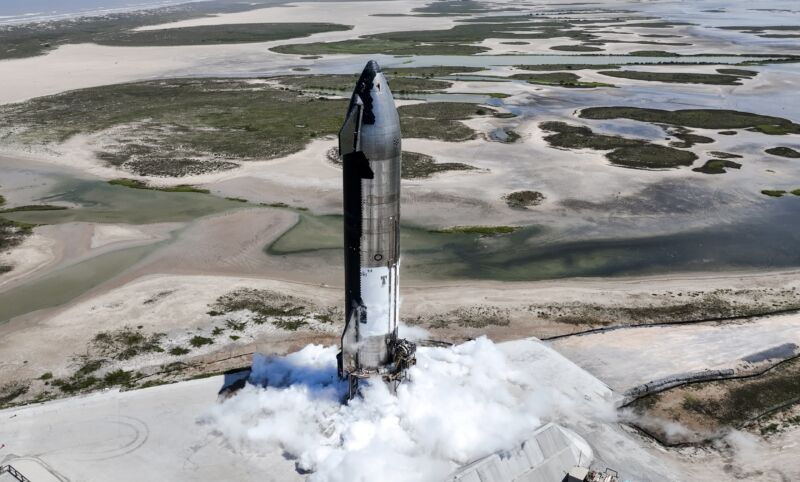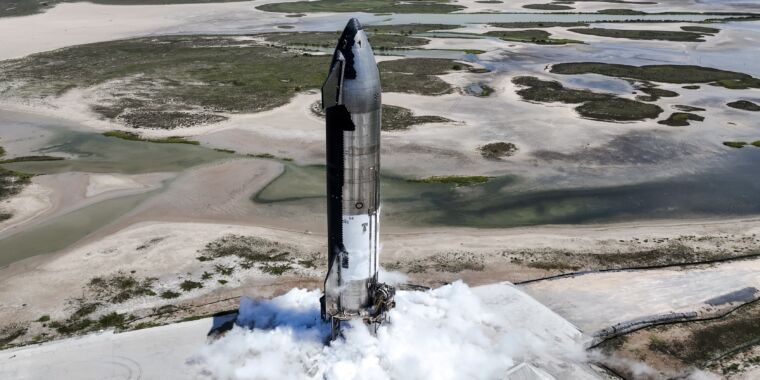
SpaceX will debut numerous upgrades on the second launch of its large-scale Starship mega rocket. Those upgrades include a major change to how the rocket’s two stages separate, improvements to the propulsion system, and a reinforced launchpad in South Texas that should be more resistant to the detonation of 33 main engines.
“There really are a ton of changes between the last Starship flight and this one, over a thousand,” said Elon Musk, SpaceX’s founder and CEO. “So I think the chances of this next flight working and getting into orbit are much higher than the last one. Maybe it’s like 60 percent. It depends on how well we do in terms of stage separation.”
Musk outlined some of the Starship missile modifications in a Twitter Spaces discussion Saturday with journalist Ashlee Vance. He said the next Starship missile and launchpad upgrades at the South Texas Starbase facility should be ready for the next test flight in about six weeks. “That’s just the best of our knowledge at this point,” Musk said.
The Starship vehicle is designed to be fully reusable, and SpaceX plans to use it to launch satellites into orbit, build tankers and propellant depots, and eventually transport cargo and crew to the Moon and Mars. SpaceX’s long-term goal is to replace its workhorse Falcon 9 rocket and Dragon crew capsule with the privately funded Starship vehicle.
SpaceX officials were pleased with the result of the first full Starship test flight on April 20, which reached an altitude of about 24 miles (38 kilometers) before spiraling out of control after multiple engine failures and the loss of the rocket’s steering system. The test flight set the record for the largest and most powerful rocket ever flown – at 394 feet (120 meters) tall with some 15 million pounds of thrust from its methane-powered Raptor engines.
The rocket is divided into two segments. A booster stage called Super Heavy with 33 Raptor engines is designed to propel the vehicle through Earth’s atmosphere, after which a six-engine upper stage – known simply as Starship – takes over to accelerate to orbital speed. During operational missions, the Starship’s upper stage could serve as a propellant tanker, payload deployment device, or crew cabin.
One of the most significant changes SpaceX is making to the Starship design is separating the booster from the upper stage, an event that occurs about three minutes after launch. The Starship test flight in April failed to reach the milestone.
“We’ve made a sort of late-breaking change that’s really, really important to the way phase separation works, which is to use what’s called ‘hot staging’ where we fire up the top stage or ship’s engines while the first stage, or booster stage, engines are still on,” Musk said.
Russian missiles, such as the venerable Soyuz, have used the hot staging technique for decades, but it is not used on any modern US launcher. Typically, rockets shut down their booster motors for a few seconds before jettisoning the first stage and igniting the upper stage motor.
Musk said SpaceX would shut down most of the Super Heavy booster’s engines and then simultaneously fire the engines on the Starship’s upper stage. The result of the change is that it increases the spacecraft’s carrying capacity, which already exceeded 100 tons in low Earth orbit. But it means engineers will have to add shielding to the top of the stainless steel booster, which SpaceX plans to recover and reuse several times over.
“Obviously that results in some kind of explosion of the booster, so you have to protect the top of the boost stage from being burned by the upper stage motors,” Musk said, adding that the design change would add about a 10 percent improvement to the payload of the Starship rocket.
Separating the stages of the rocket with the booster motors already shut down causes a loss of thrust. As the rocket temporarily continues to climb, the pull of Earth’s gravity begins to slow its speed.
“So you want to start the ship’s engines before you’ve completely shut down the booster engines,” Musk said.

